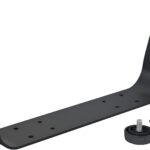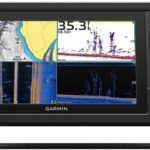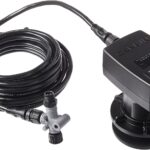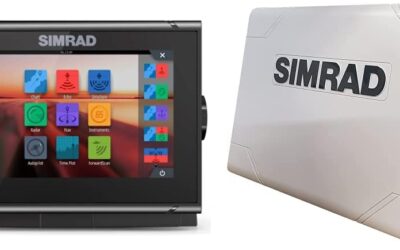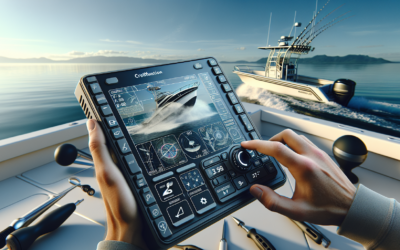Invasive species pose a significant threat to ecosystems around the world, disrupting the delicate balance and causing harm to native plants and animals. However, advancements in technology, specifically fish finders, are providing environmental managers with a powerful tool to combat these invasions. By harnessing the capabilities of fish finders, scientists and conservationists can detect and track invasive species, allowing for targeted and effective management strategies. In this article, we will explore how incorporating fish finders into environmental management practices is revolutionizing the fight against invasive species and helping to preserve our precious ecosystems.
1. Introduction
Welcome to our comprehensive guide on using fish finders as a tool for managing invasive species in environmental management. Invasive species are non-native organisms that can have detrimental effects on ecosystems, and managing their populations is crucial for preserving biodiversity and ecological balance. In recent years, advancements in technology have provided new opportunities for detecting, monitoring, and controlling invasive species. One such technology that has proven to be effective is fish finders. Fish finders, traditionally used in fishing, utilize sonar technology to locate fish in bodies of water. However, their application in environmental management is expanding as they have proven to be a valuable tool in detecting and tracking invasive species. In this article, we will delve into the definition and impact of invasive species, explore the challenges faced in managing them, and discuss how fish finders can be utilized to address these challenges. Additionally, we will explore the benefits, techniques, and technologies used in fish finders, review case studies of successful implementations, discuss the limitations and challenges posed by fish finders, and provide recommendations for effective use in invasive species management. We will also touch upon future developments and trends in the field. By the end of this article, you will have a comprehensive understanding of how fish finders can contribute to the management of invasive species and why they are an indispensable tool in environmental management.
2. Understanding Invasive Species
2.1 Definition of Invasive Species
Invasive species, also known as alien or exotic species, are organisms that are introduced to an ecosystem outside their natural distribution range. These species can have a significant impact on the native flora, fauna, and overall ecological balance. Unlike native species, invasive species often thrive and reproduce rapidly, outcompeting native species for resources such as food, shelter, and breeding sites. This can result in the depletion of native species, alteration of habitat structure, disruption of ecosystem functioning, and in some cases, even the complete collapse of an ecosystem.
2.2 Impact of Invasive Species on Ecosystems
The impact of invasive species on ecosystems can be far-reaching and profound. By outcompeting native species, they can disrupt established ecological relationships, leading to decreased biodiversity and ecosystem instability. Invasive species can also alter habitat structure, resulting in changes to nutrient cycles, water availability, and fire regimes, among other factors. This can have cascading effects on other species dependent on the affected ecosystem, including humans. Economically, invasive species can cause significant damage to industries such as agriculture, forestry, and fisheries, leading to financial losses. Additionally, invasive species are known to be carriers of diseases, both for native species and humans, further exacerbating the negative impacts they bring.
2.3 Challenges in Managing Invasive Species
Managing invasive species is a complex and challenging task. The rapid growth and reproductive rates of invasive species can make their populations difficult to control once established. Detecting invasive species early and monitoring their populations is essential but can be arduous, especially in large bodies of water or expansive ecosystems. Accurate mapping and tracking of invasive species are crucial for developing effective management strategies, but it requires detailed and up-to-date information. Furthermore, assessing the effectiveness of control measures implemented to combat invasive species can be challenging due to the difficulty in evaluating population dynamics and measuring the impact on native ecosystems. These challenges necessitate innovative and effective tools to manage invasive species and mitigate their negative effects.
3. Fish Finders as a Tool for Environmental Management
3.1 Overview of Fish Finders
Fish finders are electronic devices used primarily in recreational and commercial fishing to locate and track fish in bodies of water. These devices utilize sonar technology and can provide detailed information about fish populations, depth contours, and underwater structures. A typical fish finder consists of a display screen, transducer (which emits and receives sound waves), and a control unit. The transducer, usually mounted on a boat’s hull or a portable device, emits sound waves into the water, and upon encountering objects such as fish or the bottom of the water body, the sound waves bounce back and are detected by the transducer. The control unit processes the received signals and displays the information on the screen, allowing users to visualize and interpret the underwater environment.
3.2 Applications of Fish Finders in Environmental Management
While fish finders were initially developed for fishing purposes, their applications in environmental management have become increasingly recognized. Fish finders can be employed to detect and monitor invasive species populations, assess their distribution and abundance, and aid in the development of targeted control measures. By providing real-time data on the location and density of invasive species, fish finders enable managers and researchers to make informed decisions and implement appropriate strategies. Additionally, fish finders can contribute to the overall understanding of ecosystems by providing valuable information about the underwater habitat, including depth contours, vegetation distribution, and substrate composition. This helps in creating comprehensive management plans that take into account not only the invasive species but also the entire ecosystem.
4. Benefits of Using Fish Finders for Managing Invasive Species
4.1 Early Detection and Monitoring
Early detection is crucial in managing invasive species effectively. By identifying and detecting invasive species at the early stages of their establishment, managers can prevent further spread and implement control measures promptly. Fish finders provide a significant advantage in early detection, as they can detect and locate invasive species in large bodies of water or vast ecosystems. By continuously monitoring using fish finders, managers can track population dynamics and identify any changes in distribution or abundance, allowing for timely intervention.
4.2 Mapping and Tracking Invasive Species
Accurate mapping and tracking of invasive species are key components of effective management strategies. Fish finders, with their ability to provide precise and detailed information about the underwater environment, play a crucial role in mapping invasive species distribution and abundance. By combining the real-time data obtained from fish finders with GPS technology, managers can create highly accurate maps of invasive species populations. These maps enable targeted control measures, such as physical removal or the application of biological agents, ensuring that resources are efficiently allocated to areas where they are most needed.
4.3 Assessing the Effectiveness of Control Measures
Evaluating the effectiveness of control measures implemented to manage invasive species is critical for adaptive management and decision-making. Fish finders help in assessing the impact of control methods by monitoring changes in invasive species populations over time. By comparing pre and post-intervention data obtained through fish finders, managers can determine the success of their strategies and make informed adjustments if necessary. This iterative approach allows for continuous improvement and optimization of management efforts.
5. Techniques and Technologies Used in Fish Finders
5.1 Sonar Technology
Sonar, an acronym for Sound Navigation And Ranging, is the primary technology used in fish finders. It works by emitting sound waves, commonly referred to as pings, into the water. These sound waves travel through the water until they encounter an object, such as fish or the bottom surface. When the pings hit an object, they bounce back and are picked up by the transducer, which converts them into electrical signals. The fish finder’s control unit processes these signals and displays them as visual representations on the screen, allowing users to interpret the information.
5.2 GPS and Mapping
Global Positioning System (GPS) technology is often integrated into fish finders, enabling precise mapping and tracking of invasive species. By combining the location data obtained from GPS with the sonar data, fish finders can create accurate maps of invasive species distribution. These maps provide valuable information for decision-making and implementing targeted control measures.
5.3 Data Analysis Software
To make the most of the data collected by fish finders, specialized data analysis software is often utilized. This software allows for the visualization, manipulation, and interpretation of the collected data, enabling managers and researchers to extract relevant information and insights from the raw sonar data. Data analysis software can also assist in automating certain processes, such as species recognition and population calculations, streamlining the analysis workflow.
5.4 Integration with Other Environmental Sensors
To gain a comprehensive understanding of ecosystems and invasive species dynamics, fish finders can be integrated with other environmental sensors. For example, water quality sensors can provide information about parameters such as temperature, dissolved oxygen levels, and pH. Combining this data with the sonar data obtained from fish finders allows for a more holistic assessment of the habitat conditions and potential factors influencing invasive species populations. This integration facilitates a multi-faceted approach to environmental management, providing a deeper understanding of the complex interactions within ecosystems.
6. Case Studies: Successful Use of Fish Finders in Invasive Species Management
6.1 Case Study 1: Using Fish Finders to Control Zebra Mussels in Great Lakes
One notable case study of fish finders’ successful application in invasive species management is the control of zebra mussels in the Great Lakes. Zebra mussels, a small invasive species native to Eastern Europe, have caused significant ecological and economic damage since their introduction to the Great Lakes ecosystem in the late 1980s. Fish finders were employed to monitor the distribution and density of zebra mussel populations in various areas of the Great Lakes. The sonar technology offered by fish finders allowed for precise mapping of zebra mussel beds and their spatial extent. This information was crucial in guiding control measures, such as targeted chemical treatments and physical removal, as well as facilitating the evaluation of their effectiveness. The use of fish finders enabled early detection, rapid response, and continuous monitoring, contributing to successful management efforts in combating zebra mussels.
6.2 Case Study 2: Tracking and Managing Lionfish Populations in the Caribbean
The lionfish, a visually striking but highly invasive species, has become a growing concern in the Caribbean. As lionfish populations continue to expand rapidly, their predation on native fish species threatens the delicate balance of coral reef ecosystems. Fish finders have been instrumental in tracking and managing lionfish populations in the Caribbean. By utilizing fish finders to detect lionfish and collect data on their location and abundance, researchers and managers can develop targeted strategies for controlling their populations. This includes the deployment of trained divers equipped with fish finders to physically remove lionfish from specific areas. Fish finders aid in identifying and focusing efforts on the most heavily infested areas, maximizing the impact of control measures while minimizing disruption to the native reef communities.
7. Challenges and Limitations of Fish Finders in Environmental Management
7.1 Technological Limitations
While fish finders are valuable tools for managing invasive species, they do have certain limitations. One primary limitation is their inability to differentiate between species based on sonar data alone. Fish finders rely on the interpretation of signals reflected off objects in the water, which can be challenging when differentiating between invasive species, native species, and other underwater features. Additional methods, such as visual surveys or DNA analysis, may be needed to confirm species identity in conjunction with fish finder data. Furthermore, fish finders may not be effective in certain environments with complex habitats, dense vegetation, or high turbidity, as these conditions can affect the accuracy and quality of the sonar signals.
7.2 Cost and Accessibility
The cost of fish finders and associated equipment can be a significant barrier to their widespread implementation in invasive species management. High-quality fish finders with advanced features can be expensive, making them inaccessible to many resource-limited organizations and individuals. Additionally, the need for training and expertise in operating fish finders effectively adds to the overall costs. Ensuring affordable access to fish finder technology is crucial for expanding its use in environmental management and democratizing the benefits it brings.
7.3 Environmental and Ethical Concerns
The use of fish finders and other related technologies can raise environmental and ethical concerns. Intensive fish finder surveys, especially in sensitive aquatic ecosystems, can potentially harm the environment and disturb marine life. There is also the risk of inadvertently targeting and impacting non-target species during control measures if fish finders are not used judiciously. Additionally, the potential for increased disturbance to underwater habitats due to increased human activities associated with fish finder deployment must be carefully considered and mitigated to ensure minimal ecological impact.
8. Future Developments and Trends
8.1 Advancements in Fish Finder Technology
The field of fish finder technology is continuously advancing, with innovations and improvements being made to enhance their capabilities. Future developments may include improved sonar technology with higher resolution, enabling even more precise detection and mapping of invasive species. Integration of artificial intelligence (AI) algorithms in fish finders may facilitate automated species recognition and data analysis, eliminating the need for manual interpretation. The miniaturization and portability of fish finders may also increase, allowing for their use in a wider range of environments and applications.
8.2 Collaborative Efforts and Data Sharing
Collaboration and data sharing among researchers, managers, and stakeholders are crucial for effective invasive species management. As fish finders become more widely used, establishing platforms and protocols for sharing data will be vital in creating comprehensive and up-to-date databases. Collaborative efforts can ensure that the data collected from fish finders are utilized to their full potential, enabling better decision-making and fostering a more holistic approach to environmental management.
8.3 Incorporating Artificial Intelligence and Machine Learning
The integration of artificial intelligence (AI) and machine learning (ML) techniques holds great promise in enhancing the capabilities of fish finders for invasive species management. By training AI algorithms with large datasets of sonar and associated data, fish finders can autonomously detect, classify, and track invasive species, significantly reducing the reliance on manual interpretation. AI and ML can also help in predicting and modeling the spread and impact of invasive species, aiding managers in designing proactive control strategies.
9. Recommendations for Effective Use of Fish Finders in Invasive Species Management
9.1 Training and Education
Proper training and education are crucial when utilizing fish finders for invasive species management. Users should receive comprehensive instruction on operating fish finders, interpreting sonar data, and understanding the limitations and potential challenges associated with their use. This ensures that fish finders are used effectively and efficiently, maximizing their contribution to invasive species management efforts.
9.2 Data Standardization and Sharing
Establishing standardized protocols for data collection and sharing is essential to promote collaboration and facilitate the exchange of information. By adopting common data formats, metadata standards, and quality control measures, data collected from fish finders can be easily shared, integrated, and utilized by a wide range of stakeholders. This encourages a more coordinated and holistic approach to invasive species management, enabling better decision-making and the development of more effective strategies.
9.3 Policy and Regulatory Support
Policy and regulatory support are crucial in facilitating the effective use of fish finders in invasive species management. Governments and regulatory bodies can play a role in promoting the adoption of fish finder technology by providing financial incentives, grants, or subsidies to organizations and individuals engaged in invasive species management. Additionally, creating guidelines and regulations for the use of fish finders in sensitive environments can help mitigate potential ecological impacts and ensure responsible use.
10. Conclusion
In conclusion, fish finders offer a valuable and versatile tool for managing invasive species in environmental management. Their ability to detect, monitor, and map invasive species populations allows for early detection, targeted control measures, and effective evaluation of management strategies. While fish finders are not without limitations, ongoing advancements in technology, increasing accessibility, and collaborative efforts provide promising avenues for their continued development and utilization. By embracing the potential of fish finders and incorporating them into invasive species management practices, we can make great strides in preserving biodiversity, protecting ecosystems, and mitigating the negative impacts of invasive species. It is essential that stakeholders, including researchers, managers, and policymakers, continue to explore and support the integration of fish finders in environmental management, ensuring a sustainable and resilient future for our planet.

